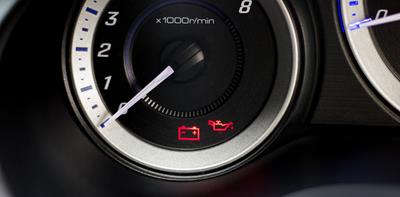
EASY AS HACK
Flat battery? Use a voltage tester such as a multimeter to measure the battery’s voltage before going to the expense of replacing.
At a glance
|
Common signs your car battery needs changing
|
How do you change a car battery?
You turn on the ignition. Nothing happens. Your heart sinks as you realise the battery’s flat. Then, you wonder, ‘How do I change a car battery’? Our step-by-step guide explains how to safely change a car battery if you decide not to take it to a garage.
What equipment do you need to change a car battery?
To change the car’s battery properly, you’ll need the following equipment:
- Replacement battery – make sure it’s the same size and voltage
- Protective equipment – including gloves and goggles
- Pliers or a spanner – to loosen nuts and bolts
- Battery terminal cleaner – to remove any corrosion
Battery acid can burn the skin, so you need to be careful. Wearing protective equipment such as gloves and goggles helps to keep you safe if your battery is damaged and leaking.[1]
How to remove the old car battery
First, turn off the ignition and remove the keys. Next, put your car in park or neutral, and make sure the handbrake is on and the engine has cooled. Then follow these simple steps:
1. Find the battery
- Locate the battery. It’s under the bonnet in most cars’ engine bays but could also be in the boot [2] and may have a plastic cover over it. If unsure of the battery’s location, Google the vehicle, make and model or check your owner’s manual.
2. Put on safety equipment
- Wear rubber gloves and safety glasses for protection. [3] Wear long sleeves and take off metal jewellery to avoid a shock from the battery or a burn from leaked acid.
3. Disconnect the negative terminal
- Find the negative (black) terminal marked with a (-) or ‘neg’ – you must disconnect it first as it can be dangerous to do so in the wrong order. [1]
- With work gloves on, use a spanner or pliers to loosen the nut on the negative terminal.
- Once loose, gently pull the cable connector away from the terminal without letting it touch the metal areas of the car. [2]
4. Disconnect the positive terminal
- Marked with a (+) or ‘pos’ (red) – you disconnect the positive terminal next
- Again, use a spanner or pliers to loosen the nut or bolt on the terminal
- Pull the cable connector up and away from the positive terminal once the bolt is loose.
5. Remove the battery hold-down brackets
- Not every car will have a restraining strap or brackets
- If yours does, undo the bolt securing the bracket(s) and lift and move it aside before the next step
6. Remove the car battery
- Carefully take the old car battery up and out (it will be heavy). Try not to tip or drop it. You don’t want to risk acid spilling onto your engine or your clothes and skin.[2]
How to install the new car battery
Here’s how to install a new car battery safely and correctly. You must connect it in the reverse order you took the old one out. [2]
1. Inspect and clean the battery terminals
- Check the tray and terminals where the battery sits to ensure no signs of damage or corrosion. Rusty deposits may sit in the tray and on the terminals.
- You can use a wire brush and spray to clean the terminals (keep your gloves on), or you can mix baking soda (2tbps) and water (1tsp) to create a paste. Steel wool is an effective way of cleaning the connectors. Rinse the tray with a bit of water and dry it thoroughly.[5]
2. Place battery into the battery terminals
- Once everything is dried thoroughly, carefully place the new battery in the same position as the old one, orienting it correctly.
- Secure the battery using the battery hold-down brackets.
3. Reconnect the battery connections
- It’s crucial to reconnect the positive cable first
- Make sure the connection is tight
- Next, reconnect the negative cable connector and tighten the nut.
- Close the bonnet and start your vehicle
Signs your car battery needs to be replaced
Various tell-tale signs will tell you that your car battery is ending its life or is flat. They include:
- No response when you turn or press the ignition
- Car engine is slow to crank or you hear clicking noises
- Dim headlights (although this can indicate alternator issues) [5]
- Battery warning lights appear on the dashboard
- Charging system warning lights appear
- The battery is leaking acid
- Noticeable cracks in the battery
If your battery is dead or flat, you can try jump-starting it before going to the expense of a complete replacement. Read our tips on how to jump start your car. If the battery keeps dying or is damaged, you must replace it.
You can also use a tester, such as a multimeter, to measure the battery’s voltage before deciding whether it needs replacing.[5] Doing this in the morning is best, and a healthy battery should read 12.6 volts.[6]
How often does a car battery need replacing?
A car battery, whether for a petrol, diesel or electric vehicle, has no set life, although the average is 3-5 years.[2]
How long it lasts before it needs replacing depends on various factors, such as:
- Quality of the battery
- How often you drive your car
- Driving conditions
- Climate – especially extremes in temperature
- How well you maintain the battery
How much does a car battery cost
A conventional car battery costs from £65 to £284. The price depends on your car (conventional or start-stop), the brand, and the battery’s quality.[8] Make sure you check whether the price includes fitting.
A battery for an electric car does cost significantly more; but on average they are expected to last between ten and twenty years.[9]
How to maintain your car battery
You can preserve or maintain your car battery’s performance by taking the following actions:
- Ensure the battery is properly secured
- Make sure it is properly installed
- Check that the connections are tight
- Inspect regularly for signs of corrosion, leaks or damage [2]
- Keep terminals clean
- Drive the vehicle regularly
- Don’t leave the car’s lights on overnight [1]
- Store your car properly if you are not driving it for extended periods or during extreme weather.[8]
Ageas car insurance can protect you from battery failure and breakdowns.
FAQS
How long does replacing a car battery take?
Replacing a car battery takes an hour or less. [3]
Can I test my car battery myself?
Yes, you can test a car battery using a multimeter, although many garages will check it for free.
What happens if you replace a car battery with wrong battery?
If you replace a car battery with the wrong battery, it might not sit properly in its compartment if it’s too big. A battery that’s too large may cause a short circuit, while a battery that’s too small could lead to ignition issues
What happens if I remove the positive terminal first?
A potentially dangerous electrical short happens if you remove the positive terminal first – removing the negative cable first is designed to prevent this.
Read our blog on how to jump start your car
Sources
[1] https://www.ageas.co.uk/solved/your-car/how-to-jump-start-your-car/
[2] https://www.rac.co.uk/drive/advice/car-maintenance/how-to-change-a-car-battery-all-you-need-to-know/
[3] https://www.familyhandyman.com/project/how-to-change-a-car-battery/
[5] https://www.businessinsider.com/guides/home/how-to-change-a-car-battery
[6] https://haynes.com/en-us/tips-tutorials/how-test-car-battery-multimeter
[7] https://batteryworld.varta-automotive.com/en-be/what-happens-to-the-battery-during-summer
[8] https://www.ageas.co.uk/solved/your-car/how-to-look-after-your-car-when-youre-not-using-it/


